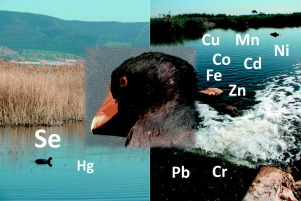Science of the Total Environment ( IF 8.2 ) Pub Date : 2018-07-20 , DOI: 10.1016/j.scitotenv.2018.07.265 Jhon J. López-Perea , Celia Laguna , María Jiménez-Moreno , Rosa C. Rodríguez Martín-Doimeadios , Jordi Feliu , Rafael Mateo

|
We addressed the hypothesis that birds in eutrophic wetlands receiving wastewater treatment plant (WWTP) effluents are exposed to high levels of metals and metalloids and this may drive an ecological trap in some species attracted to these highly productive ecosystems. Levels of metals and metalloids were determined in sediment and in blood and feathers of common moorhens (Gallinula chloropus) from two wetlands in Central Spain: Navaseca Pond, which receives directly the effluent of a WWTP; and Tablas de Daimiel National Park, which is a floodplain less affected by urban discharges. Sediment concentrations of Cr, Mn, Fe, Co, Ni, Cu, Zn, Cd and Pb were higher in Navaseca Pond than in Tablas de Daimiel; only Se was higher in Tablas de Daimiel than in Navaseca. Blood levels of Hg and Se were higher in moorhens from Tablas de Daimiel than those from Navaseca. In the case of Hg these levels were below the threshold of adverse effect, but Se levels in 24% of moorhens from Tablas de Daimiel were above the threshold value associated with Se toxicity in birds (1000 ng/mL). In feathers, Hg, Se, Mn, Cu and As levels were higher in Tablas de Daimiel than in Navaseca. Body condition of moorhens was negatively associated with blood Se levels in the moorhens from Tablas de Daimiel. We can reject the hypothesis of a higher accumulation of metals and metalloids in birds associated with the WWTP effluent, but Se levels may need further research considering the nature of the floodplain of Tablas de Daimiel National Park.
中文翻译:

接受处理后的湿地普通雌狐(Gallinula chloropus)血液和羽毛中的血液和金属中的金属和类金属。
我们解决了一个假设,即富营养化湿地中接受废水处理厂(WWTP)废水的鸟类暴露于高水平的金属和准金属,这可能会导致某些物种被这些高产生态系统所吸引而形成生态陷阱。测定了普通雌红sediment(Gallinula chloropus)的沉积物,血液和羽毛中的金属和类金属含量。)来自西班牙中部的两个湿地:纳瓦塞卡池塘,直接接收污水处理厂的污水;以及塔布拉斯·戴米米尔国家公园(Tablas de Daimiel National Park),这是一个受城市污水影响较小的洪泛区。纳瓦塞卡池塘中的Cr,Mn,Fe,Co,Ni,Cu,Zn,Cd和Pb的沉积物浓度高于Tablas de Daimiel。Tablas de Daimiel中只有Se高于Navaseca。Tablas de Daimiel的雌红中的Hg和Se血液水平高于Navaseca中的雌红。在汞的情况下,这些水平低于不良反应阈值,但是来自Tablas de Daimiel的红mo中24%的雌鸟中的硒水平高于与鸟类中硒毒性相关的阈值(1000 ng / mL)。在羽毛中,Tablas de Daimiel中的Hg,Se,Mn,Cu和As含量高于Navaseca。雌红松的身体状况与来自Tablas de Daimiel的雌红的血液中硒水平呈负相关。我们可以否定与污水处理厂废水相关的鸟类中金属和准金属含量更高的假设,但是考虑到塔布拉斯·戴米尔国家公园洪泛区的性质,可能需要进一步研究硒水平。











































 京公网安备 11010802027423号
京公网安备 11010802027423号